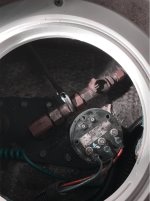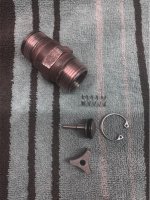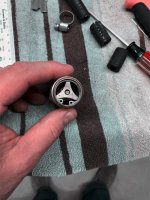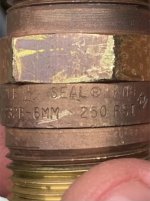I have a 1989 Viking 35 sportfish. I've been dealing with a generator fuel starvation/priming issue since I got the boat 3 years ago. I solved a variety of problems with the genset and when I can keep the fuel flowing it runs and performs great, but given how hard it's been to prime the fuel line and keep it that way I decided to pull the fuel pickup and check the anti siphon valve for proper operation. For reference it's about 15-20' from tank to genset filters.
It was hard to get the fittings apart, and at this point I have not got the pickup tube out, but what I found was a check valve, not an anti siphon valve. Perhaps they solve the same issue. The check valve being so close to tank is being used to solve just the issue I'm having, the fuel draining back to the tank and priming issues given the length of hose run.
Anyway, the check valve appeared to be very difficult to operate. I assumed it was junk. But after a thorough cleaning, it still appears very stiff, but maybe I don't have an appreciation of what is needed to generate 2psi for the cracking pressure of this valve by blowing through it. The electric fuel pump is rated for 2-5psi, so I think it's having a hard time keeping the valve open. If I help it get the flow going with a primer level, it will keep flowing and running. Additionally, and I'm told this can be done but isn't as common, the check valve is installed on the suction side of the pump, with the valve at the tank and the fuel pump mounted to the genset. So it's pulling the check valve open vs pushing it with flow.
This is a big CV too, with 3/4 NPT threads.
Questions are:
1. Should I try to find a check valve with a lower cracking pressure, or could mine actually be bad? Should 2 psi be easy to get it to open? I'm not sure how to test it properly. But me blowing through it is like I'm trying to blow up a balloon.
2. Is it ok to have this on the suction side of the pump, essentially keeping the whole fuel line and pump full of fuel? Will it work ok this way (Viking certainly thinks so, as this is how they built the boat).
Here's some pics of the check valve and fuel tank fittings. Thanks!
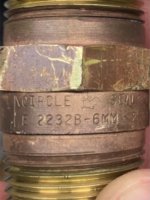
It was hard to get the fittings apart, and at this point I have not got the pickup tube out, but what I found was a check valve, not an anti siphon valve. Perhaps they solve the same issue. The check valve being so close to tank is being used to solve just the issue I'm having, the fuel draining back to the tank and priming issues given the length of hose run.
Anyway, the check valve appeared to be very difficult to operate. I assumed it was junk. But after a thorough cleaning, it still appears very stiff, but maybe I don't have an appreciation of what is needed to generate 2psi for the cracking pressure of this valve by blowing through it. The electric fuel pump is rated for 2-5psi, so I think it's having a hard time keeping the valve open. If I help it get the flow going with a primer level, it will keep flowing and running. Additionally, and I'm told this can be done but isn't as common, the check valve is installed on the suction side of the pump, with the valve at the tank and the fuel pump mounted to the genset. So it's pulling the check valve open vs pushing it with flow.
This is a big CV too, with 3/4 NPT threads.
Questions are:
1. Should I try to find a check valve with a lower cracking pressure, or could mine actually be bad? Should 2 psi be easy to get it to open? I'm not sure how to test it properly. But me blowing through it is like I'm trying to blow up a balloon.
2. Is it ok to have this on the suction side of the pump, essentially keeping the whole fuel line and pump full of fuel? Will it work ok this way (Viking certainly thinks so, as this is how they built the boat).
Here's some pics of the check valve and fuel tank fittings. Thanks!



